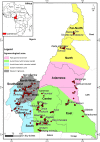Spodoptera frugiperda Smith (Lepidoptera: Noctuidae) in Cameroon: Case study on its distribution, damage, pesticide use, genetic differentiation and host plants
- PMID: 31034480
- PMCID: PMC6488053
- DOI: 10.1371/journal.pone.0215749
Spodoptera frugiperda Smith (Lepidoptera: Noctuidae) in Cameroon: Case study on its distribution, damage, pesticide use, genetic differentiation and host plants
Erratum in
-
Correction: Spodoptera frugiperda Smith (Lepidoptera: Noctuidae) in Cameroon: Case study on its distribution, damage, pesticide use, genetic differentiation and host plants.PLoS One. 2019 Jun 4;14(6):e0217653. doi: 10.1371/journal.pone.0217653. eCollection 2019. PLoS One. 2019. PMID: 31163054 Free PMC article.
Abstract
Maize farmers in sub-Saharan Africa recently experienced unusual damage in their farms, attributed to the fall armyworm (FAW) Spodoptera frugiperda (J. E. Smith). This pest was first recorded in Africa in 2016, but detailed information on its distribution and damage and farmer's response in invaded areas are largely lacking. In this study, we determined FAW distribution, genetic diversity, host plants, crop damage, and farmers' responses. S. frugiperda was recorded in the 10 regions of Cameroon. Average percentage of infested plants and damage severity (on a scale of 1 to 5) were lowest-20.7 ± 7.4% and 2.1 ± 0.1 respectively-in the Sahelian regions and greatest-69.0 ± 4.3% and 3.1 ± 0.1 respectively-in the Western Highlands. Altitude did not influence FAW incidence and severity and its larvae infrequently co-occurred with maize stemborers on the same plants, suggesting possible direct and/or indirect competition between the two groups of maize pests. In response to this new threat to maize production, farmers have opted for the application of synthetic pesticides. Although our experiments were not designed to determine pesticide efficacy, as parameters such as time since application were not considered, our observations suggest lack of a drastic effect on S. frugiperda infestations on maize. There were two haplotypes of FAW co-occurring in Cameroon corresponding to the rice and corn strains and separated by 1.7% sequence divergence, which does not support the existence of cryptic species. S. frugiperda larvae were also recorded on Sorghum bicolor (L.) Moench (10.6%), Solanum tuberosum L. (2.8%), Ipomoea batatas (L.) Lam. (1.9%), Saccharum officinarum L (0.8%), Phaseolus vulgaris L. (0.4%) and Gossypium hirsutum L. (1.9%). This study show that two strains are present in all agroecological zones in Cameroon, and probably in neighboring countries of central Africa sharing the same agroecologies. Management options should therefore consider the use of specific natural enemies and an informed decision of intervention based on strain capture and damage threshold, to avoid pesticide resistance that may arise from inadequate use of chemicals. Further studies should also be undertaken to assess the response of the two S. frugiperda strains to biopesticides and botanical insecticides.
Conflict of interest statement
The authors have declared that no competing interests exist.
Figures







Similar articles
-
Population density of the fall armyworm, Spodoptera frugiperda (Smith) (Lepidoptera: Noctuidae) and its response to some ecological phenomena in maize crop.Braz J Biol. 2023 Apr 7;83:e271354. doi: 10.1590/1519-6984.271354. eCollection 2023. Braz J Biol. 2023. PMID: 37042913
-
Genetic analyses and detection of point mutations in the acetylcholinesterase-1 gene associated with organophosphate insecticide resistance in fall armyworm (Spodoptera frugiperda) populations from Uganda.BMC Genomics. 2023 Jan 16;24(1):22. doi: 10.1186/s12864-022-09093-4. BMC Genomics. 2023. PMID: 36646998 Free PMC article.
-
Occurrence of natural enemies of fall armyworm, Spodoptera frugiperda (Lepidoptera: Noctuidae) in Nigeria.PLoS One. 2021 Jul 12;16(7):e0254328. doi: 10.1371/journal.pone.0254328. eCollection 2021. PLoS One. 2021. PMID: 34252127 Free PMC article.
-
Opportunities and Scope for Botanical Extracts and Products for the Management of Fall Armyworm (Spodoptera frugiperda) for Smallholders in Africa.Plants (Basel). 2020 Feb 6;9(2):207. doi: 10.3390/plants9020207. Plants (Basel). 2020. PMID: 32041322 Free PMC article. Review.
-
Integrated management of Spodoptera frugiperda 6 years post detection in Africa: a review.Curr Opin Insect Sci. 2022 Aug;52:100928. doi: 10.1016/j.cois.2022.100928. Epub 2022 May 6. Curr Opin Insect Sci. 2022. PMID: 35534003 Review.
Cited by
-
Natural Enemies of Fall Armyworm Spodoptera frugiperda (Lepidoptera: Noctuidae) in Different Agro-Ecologies.Insects. 2021 May 31;12(6):509. doi: 10.3390/insects12060509. Insects. 2021. PMID: 34072988 Free PMC article.
-
Molecular surveillance of resistance mutations in invasive populations of Spodoptera frugiperda in Europe, for evidence-based pest control.Pest Manag Sci. 2025 Aug;81(8):4821-4830. doi: 10.1002/ps.8849. Epub 2025 Apr 25. Pest Manag Sci. 2025. PMID: 40276957 Free PMC article.
-
Bionomic responses of Spodoptera frugiperda (J. E. Smith) to lethal and sublethal concentrations of selected insecticides.PLoS One. 2023 Nov 15;18(11):e0290390. doi: 10.1371/journal.pone.0290390. eCollection 2023. PLoS One. 2023. PMID: 37967118 Free PMC article.
-
Estimating the Cost of Production of Two Pentatomids and One Braconid for the Biocontrol of Spodoptera frugiperda (Lepidoptera: Noctuidae) in Maize Fields in Florida.Insects. 2023 Feb 9;14(2):169. doi: 10.3390/insects14020169. Insects. 2023. PMID: 36835738 Free PMC article.
-
Fall Armyworm Spodoptera frugiperda (Lepidoptera: Noctuidae) in South Kivu, DR Congo: Understanding How Season and Environmental Conditions Influence Field Scale Infestations.Neotrop Entomol. 2021 Feb;50(1):145-155. doi: 10.1007/s13744-020-00833-3. Epub 2021 Jan 26. Neotrop Entomol. 2021. PMID: 33501633
References
-
- Brewbaker JL. Corn production in the tropics: the Hawaii experience [Internet]. Manoa; 2003. Available: www.ctahr.hawaii.edu.
-
- Akanvou L, Akanvou R, Koffi C, Saraka D. Evaluation agronomique des variétés de maïs riches en protéines de qualité (MRP) en station et en milieu paysan dans la zone forestière de côte d’ivoire. Agron Africaine. 2009;21: 309–317. Available: file:///C:/Users/IITACA-IT/Downloads/56461-96229-1-PB.pdf.
-
- Badu-Apraku B, Fakorede MAB. Maize in Sub-Saharan Africa: Importance and Production Constraints Advances in Genetic Enhancement of Early and Extra-Early Maize for Sub-Saharan Africa. Cham: Springer International Publishing; 2017. pp. 3–10. 10.1007/978-3-319-64852-1_1 - DOI
-
- FAO. Food and agriculture data [Internet]. 2018 [cited 27 Feb 2018]. Available: http://www.fao.org/faostat/en/#home.
-
- Ngoko Z, Cardwell KF, Marasas WFO, Wingfield MJ, Ndemah R, Schulthess F. Biological and physical constraints on maize production in the Humid Forest and Western Highlands of Cameroon. Eur J Plant Pathol. 2002;108: 893–902. Available: https://www.fabinet.up.ac.za/publication/pdfs/230-2002_ngoko_cardwell_ma...

